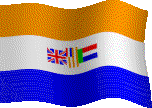

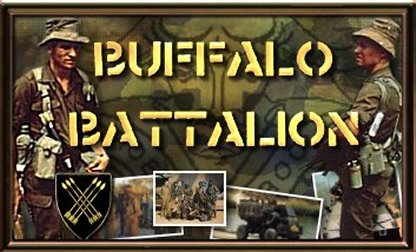
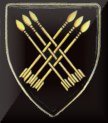
 32
Battalion was the premier Unit of the Old South African Defence Force. From its
inception in 1975 until it's disbandment in the 1990's it was the most feared
Unit by it's foes in Angola and South West Africa, and accounted for more
enemies than any other Unit of the South African Defence Force.
32
Battalion was the premier Unit of the Old South African Defence Force. From its
inception in 1975 until it's disbandment in the 1990's it was the most feared
Unit by it's foes in Angola and South West Africa, and accounted for more
enemies than any other Unit of the South African Defence Force.
Known as "Os Terriveis - "The Terrible Ones" by SWAPO, FAPLA and their Cuban Allies, this nickname became a proud one indeed
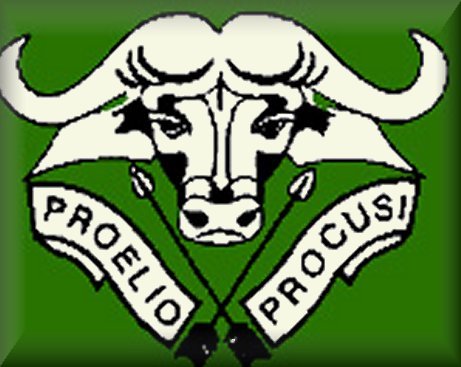
The civil war that followed the Portuguese withdrawal from Angola in 1975 ended in a triumph for the left wing Movimento Popular de LibertašÔo de Angola (MPLA). The MPLA immediately consolidated its victory by driving its main contender for power, the right wing Frente Našional de LibertašÔo de Angola (FNLA) together with its white Mercenary recruits over the Angolan border into Zaire, and South West Africa. Many of the FNLA troops thus driven out of their homeland found a refuge in what was destined to become the most feared unit in the South African Defence Force ,if not the whole of Africa.
The Unit was started by Colonel Jan Breytenbach from the remnants of this defeated FNLA cadre, and was known initially as Bravo Group and was later redesignated 32 Battalion after Breytenbach refused to abandon them as ordered. In 1975 the Unit comprised of 2 Rifle Companies, a Mortar Platoon, an Anti-tank Section and a Machinegun Platoon. With the help of members of the Recce's and Citizen Force this ragtag and bobtail Unit went off to war. Pretty soon they had routed most of the opposition. The Unit was very fortunate to have Breytenbach as their first O.C. and the doctrine of operating behind enemy lines and hitting them when and where they least expected it, remained one of the cornerstones of the Unit. Unlike other SADF Units 32 Battalion was deployed solely as a counter insurgency unit although towards the end of hostilities they were also employed as a semi-conventional force.
32-Battalion, of which
Colonel Jan Breytenbach was the founding commander, became the most
controversial unit in the South African Army because of the secrecy surrounding
it. Its story is virtually the story of the Angolan/Namibian war, because its
involvement in it was greater than any other South African unit.The battalion
primarily consisted of black troops and NCOs originating from virtually every
tribe in Angola. They were led by white South African officers and NCOs.
Neither apartheid nor any form of racial discrimination was ever practiced in
the unit.
There was always a sprinkling of whites originating from countries like Great
Britain, the old Rhodesia, Portugal and the USA amongst its leadership cadre,
although in the latter stages of its existence this shrank to only a few. Such a
presence undoubtedly led to stories circulating that the unit was a led by
foreign white mercenaries. While it was true that the black Angolan element
could have fallen with the mercenary definition, the whites involved were
attested soldiers in the South African Army. In any case, they formed a minority
and the vast majority of white officers and NCOs were born South Africans.
The
unitĺs aggressiveness and the successes it achieved in the field of battle,
often against incredible odds, lay in its spirit and its Esprit
de Corps.
32-Battalion
consistently outfought both FAPLA, SWAPO and the Cubans in the Angola bush
throughout the war years. It created a problem to which neither they nor their
Soviet and East German mentors ever found a solution to.
After the 1989 Namibian settlement the unit was with withdrawn to South Africa
where they were deployed to effectively deal with MK infiltrations into the
north of South Africa. From there, after the unbanning of the ANC in 1990, they
were redeployed to deal with political troubles, principally between armed ANC
self defence units and armed units of the IFP. The intrusion of black foreigners
into the townships who were prepared to deal with troubles robustly and without
fear or favour, did not suit either the ANC or the IFP, as they could not be
subverted to support local causes because they held no local tribal allegiances.
In the end
it seems they became a bargaining chip at the CODESA negotiations, designed to
sell out the people of South Africa , to the Marxist ANC.
Despite it having borne the brunt of South Africaĺs war in Angola with the
blood of its troops, De Klerk disgracefully ordered its arbitrary disbandment in
March 1993 and the unit ceased to exist.
None
of those who sacrificed 32ĺs dead on the altar of personal gain and political
expediency cared, what was worse that those who voted and gave De Klerk the
go-ahead to hand over the country to Mandela were never aware
of the many sacrifices 32 made for ┴frica Sul
When De Klerk handed over South West Africa to SWAPO, this ragged band of soldiers had matured into a fully mechanised fighting force second to none, and was one of the finest light infantry forces in history. Equipment included Ratel APC's (20, 90 and ZT's), 127mm Valkiri MLR's, 120mm Mortars, G6 Self Propelled 155mm Howitzers etc. Breytenbach, more than most South African Soldiers subscribed to Frederick the Great's adage of "L'Audace - L'Audace - Toujours L'Audace" and this remained the credo of the Unit.
32 did most of the fighting and dying for a Country that ultimately betrayed them, despite promises that they would not be left in the lurch. What happened to 32 is unfortunately nothing new, during Roman times Marcus Flavinius a Centurion of the second Cohort of the Augusta Legion wrote the following to his cousin Tertullus in Rome :
"We had been told, on leaving our native soil, that we were going to defend the sacred rights conferred on us by so many of our citizens settled overseas, so many years of our presence, so many benefits brought by us to populations in need of our assistance and our civilization.
"We were able to verify that all this was true, and, because it was true, we did not hesitate to shed our quota of blood, to sacrifice our youth and our hopes. We regretted nothing, but whereas we over here are inspired by this frame of mind, I am told that in Rome factions and conspiracies are rife, that treachery flourishes, and that many people in their uncertainty and confusion lend a ready ear to the dire temptations of relinquishment and vilify our action.
"I cannot believe that all this is true and yet recent wars have shown how pernicious such a state of mind could be and to where it could lead.
"Make haste to reassure me, I beg you, and tell me that our fellow-citizens understand us, support us and protect us as we ourselves are protecting the glory of the Empire.
"If it should be otherwise, if we should have to leave our bleached bones on these desert sands in vain, then beware of the anger of the Legions ! ! "
No other units in the South African Defence Force, barring the Reconnaissance Commandos, were more highly decorated than 32 and the tally of 14 Honoris Crux decorations testify to the sacrifices that this unit made for their adopted Country. Most of the Honoris Crux decorations awarded to members of the Recces were for operations performed outside South Africa and South West Africa, and a number of those awarded were for operations in conjunction with 32.
To all those who died but especially for those whose bodies were left behind in Angola - We tried to bring you home - Your graves are unmarked on any map but they are marked on our hearts forever.
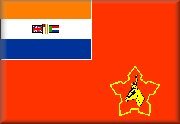
You can reach me by e-mail at: henning@flecha.co.uk
Links:
![]() South African Special Forces League
South African Special Forces League
![]() Buccaneer strike against Swapo terrorists at Cassinga in 1978.
Buccaneer strike against Swapo terrorists at Cassinga in 1978.
![]() Militaria and Cam on the net Roan Gouws
Militaria and Cam on the net Roan Gouws
![]() Galago Books : Warfare in Southern Africa
Galago Books : Warfare in Southern Africa
| www.loudkaraoke.com | |

![]()
copyright Cobus Venter 2006